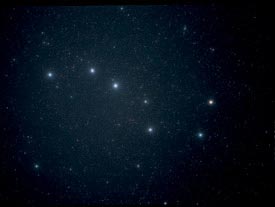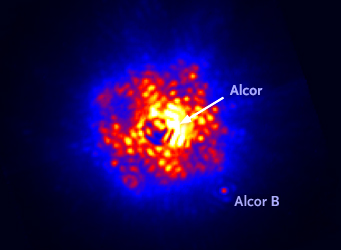It's no secret that at community star parties I bring small, squat telescopes specifically to attract little kids in the crowd. And one of my favorite targets is the paired stars Alcor and Mizar in the Big Dipper's handle.

Look for Mizar and Alcor in the bend of the handle of the Big Dipper. Spotting these two stars with the naked eye is a good test of your vision!
I tell the kids this is a "star with a secret." With just the slightest optical aid, they can make out both stars, along with an unrelated field star known as Sidus Ludoviciana that lurks nearby, creating a satisfying little triangle.
Then I ask them to train their attention on the brightest of the three (bumping up the magnification if needed), and they quickly realize that Mizar is actually a double star. I cap off my little spiel by noting that each of those two stars is itself double. So one star by eye in the Big Dipper's handle is really six stars.
Now I can make that seven!

Keen-eyed observers can tell that the bend in the Big Dipper’s Handle is actually marked by two stars, Alcor (at far left) and Mizar, very close together. Seen through a telescope, Mizar and Alcor appear to have a third companion. And Mizar is itself a true binary system, that is, two close-together stars orbiting each other. The faint, unrelated star near the bottom, HD 116798, is known as Sidus Ludoviciana.
S&T: Richard Tresch Fienberg
Astronomers recently discovered that Alcor is also a binary. Neil Zimmerman and Ben Oppenheimer, affiliated with Columbia University and New York's American Museum of Natural History, led the 19-member observing team that made the find. They've announced their discovery online and in a forthcoming issue of the Astrophysical Journal.
Curiously, the observers weren't looking for double stars when they slewed the giant 5-meter eye at Palomar Observatory over to Alcor. They've been hunting for extrasolar planets at near-infrared wavelengths as part of an effort called Project 1640. Their detector uses adaptive optics to steady the atmospheric seeing and a coronagraph mask to block the light from individual stars, in the hope of glimpsing much fainter planets that would otherwise be hopelessly lost in the star's glare.
Alcor's companion first turned up last March 16th. "“Right away I spotted a faint point of light next to the star,” says Zimmerman in a press release. “No one had reported this object before, and it was very close to Alcor, so we realized it was probably an unknown companion star.”

A color-coded infrared image reveals a faint companion to the star Alcor (masked from view at center) situated just 1 arcsecond away.
B. Oppenheimer / Project 1640
However, another explanation is that it's an unrelated star coincidentally within 1 arcsecond of our line of sight to Alcor. Ordinarily it might have taken decades to determine whether the two stars were indeed twirling in slow motion around each other. But Alcor is quite close to us, interstellarly speaking, just 80 light-years away, and that allowed the team to use a novel technique to get a definitive answer much more quickly.
They reimaged the pair on June 27th, when Earth had swung to a different side of its orbit, and compared the two images. If the newfound star were much farther away, its position would have shifted relative to Alcor due to parallax. (It wouldn't have been much, the observers note, only about 0.034 arcsecond.) But it didn't, confirming that the two stars were truly together in space.
Alcor B turns out to be an M dwarf with only about a quarter the Sun's mass. Alcor, by comparison, is a much hotter and brighter A star with twice the Sun's mass.
It's wonderfully fitting that this discovery comes during the International Year of Astronomy, celebrating Galileo's telescopic discoveries made 400 years ago. In confirming the Copernican theory that Earth revolved around the Sun, Galileo insightfully realized that such changes in stars' positions should be possible. In fact, the great Italian astronomer attempted to discover a shift in relative positions among Alcor, Mizar A and B, and Sidus Ludoviciana (also designated HD 116798), but his telescopes just weren't up to the task.
 7
7
Comments
Richard Sauder
December 13, 2009 at 3:26 pm
I must be mathematically challenged if the Mizar/Alcor star system is claimed to contain seven stars.
If Sidus Ludoviciana is really an unrelated field star as stated in the article, then it IS just that, an unrelated field star. It is therefore NOT part of the Mizar/Alcor system. Is that not so?
You must be logged in to post a comment.
Kelly Beatty
December 13, 2009 at 7:26 pm
Richard: I never claim (either to the little kids or in my story) that all seven are part of the same system — only that they collectively make up the star at the bend in the Big Dipper's handle.
You must be logged in to post a comment.
Art Trail
December 14, 2009 at 6:51 am
I am sure that I am simply not reading the article correctly, but this is what I am grasping:
Mizar + Mizar Companion + Alcor + Alcor Companion + Sidus Ludoviciana = 5. I am not understanding how there are 7 stars here. Can someone help me correct my ignorance?
Thanks!
You must be logged in to post a comment.
Björn Gimle
December 14, 2009 at 9:40 am
BOTH components of MIZAR are double
Thus 2 + 2 + 1 + 1 + 1 = 7
You must be logged in to post a comment.
Joe Stieber
December 14, 2009 at 2:56 pm
It's been my experience at public star watches that the kids are pretty good at picking up Alcor with their unaided eyes. Before looking through the scope, I ask them to look carefully at the middle star in the Big Dipper's handle. Frequently, they'll declare it's two stars before I have to prompt them to look more closely. To keep them honest, I have them tell me the clock face position of Alcor relative to Mizar. The adults don't do as well as the kids with this challenge (don't we all wish we had young eyes!). BTW, our public star watches are at relatively dark places in the NJ Pinelands; this challenge doesn't work as well in suburban skies.
You must be logged in to post a comment.
Juraj Patekar
December 15, 2009 at 8:16 am
it contains 7 stars since mizar`s double is each a double making it a double-double system + alcor 2 stars and sidus luco making it total of 7 strs
You must be logged in to post a comment.
Richard Sauder
December 19, 2009 at 6:57 pm
Kelly,
It just seems to me that, to quote you, " they collectively make up the star at the bend in the Big Dipper's handle." comes awfully close to saying that they all belong to the same star system.
Peace
You must be logged in to post a comment.
You must be logged in to post a comment.